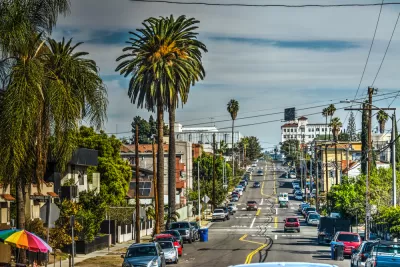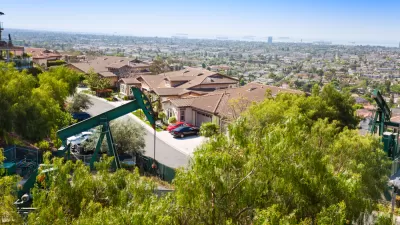Residents of Los Angeles who drive less are exposed to higher rates of air pollution due to policies that have encouraged commuting through low-income neighborhoods.

“Los Angelenos who drive less are exposed to more air pollution, as commuters from predominantly white neighborhoods travel through non-white areas,” according to a new study from the USC Sol Price School of Public Policy. A larger share of the city’s non-white residents experience air pollution than their white peers, regardless of their income.
As Christian Hetrick explains, this is in large part a result of historical planning decisions that discriminated against communities of color. “Twentieth-century planners bulldozed urban areas to build freeways for suburban residents to drive to job centers. Although whiter and wealthier areas like Beverly Hills successfully blocked such projects, similar opposition efforts failed in less-white and less-wealthy parts of L.A., such as Boyle Heights, which was carved up by five freeways and two enormous interchanges.”
The study’s authors suggest some policy fixes that could begin undoing these inequities. These include raising fuel efficiency standards and promoting cleaner transportation, enacting congestion pricing and promoting remote work to reduce driving, and reforming zoning laws to permit more housing construction in job-rich areas and less polluted neighborhoods.
FULL STORY: Pollution Paradox: Study finds L.A. residents who drive less are exposed to more air pollution

Planetizen Federal Action Tracker
A weekly monitor of how Trump’s orders and actions are impacting planners and planning in America.

Map: Where Senate Republicans Want to Sell Your Public Lands
For public land advocates, the Senate Republicans’ proposal to sell millions of acres of public land in the West is “the biggest fight of their careers.”

Restaurant Patios Were a Pandemic Win — Why Were They so Hard to Keep?
Social distancing requirements and changes in travel patterns prompted cities to pilot new uses for street and sidewalk space. Then it got complicated.

California Homeless Arrests, Citations Spike After Ruling
An investigation reveals that anti-homeless actions increased up to 500% after Grants Pass v. Johnson — even in cities claiming no policy change.

Albuquerque Route 66 Motels Become Affordable Housing
A $4 million city fund is incentivizing developers to breathe new life into derelict midcentury motels.

DC Area County Eliminates Bus Fares
Montgomery County joins a growing trend of making transit free.
Urban Design for Planners 1: Software Tools
This six-course series explores essential urban design concepts using open source software and equips planners with the tools they need to participate fully in the urban design process.
Planning for Universal Design
Learn the tools for implementing Universal Design in planning regulations.
Heyer Gruel & Associates PA
JM Goldson LLC
Custer County Colorado
City of Camden Redevelopment Agency
City of Astoria
Transportation Research & Education Center (TREC) at Portland State University
Camden Redevelopment Agency
City of Claremont
Municipality of Princeton (NJ)



























